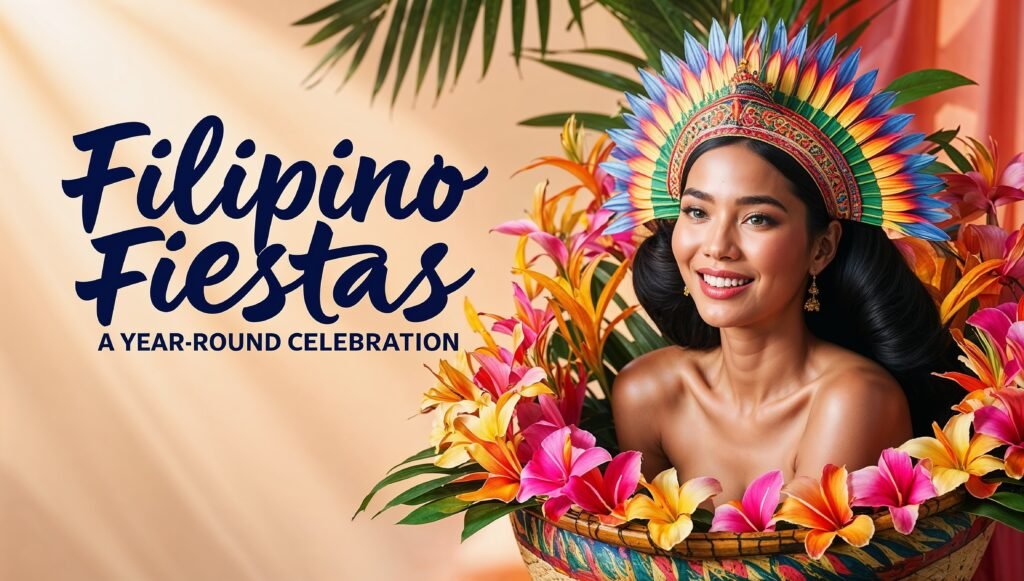Hey there, mga kaibigan! It’s Iza Cruz, and today we’re diving into something that’s close to my heart and probably yours too – Filipino fiestas! 🎉🇵🇭 As someone who’s grown up surrounded by the vibrant tapestry of our culture, I can’t wait to take you on a journey through the colorful, chaotic, and absolutely captivating world of Filipino celebrations. So, grab your favorite merienda, settle in, and let’s explore the year-round fiesta fever that keeps our islands buzzing with life!
The Heart of Filipino Culture: Why Fiestas Matter
Before we jump into the whirlwind tour of our most beloved fiestas, let’s take a moment to understand why these celebrations are more than just parties – they’re the lifeblood of Filipino culture.
In the Philippines, fiestas are not just events; they’re a way of life. They’re the threads that weave together our communities, connecting us to our roots, our faith, and each other. Growing up, I remember my Lola (grandmother) telling me, “Iza, anak, fiestas are how we Filipinos paint our joy on the canvas of life.” And you know what? She was absolutely right.
Fiestas serve multiple purposes in our society:
- Cultural Preservation: They keep our traditions alive, passing them down from generation to generation.
- Community Bonding: Fiestas bring people together, strengthening social ties and fostering a sense of belonging.
- Economic Boost: Many local businesses thrive during fiesta seasons, supporting livelihoods.
- Tourism Draw: Our colorful celebrations attract visitors from all over the world, showcasing Filipino hospitality.
- Spiritual Expression: Many fiestas have religious roots, allowing people to express their faith collectively.
But here’s the thing – fiestas aren’t just about the big, flashy parades or the mouth-watering spreads (though those are definitely highlights!). They’re about the shared laughter, the stories exchanged over steaming plates of lechon, and the pride that swells in our chests as we watch our culture come alive in the streets.
The Fiesta Calendar: A Year-Round Affair
Now, let’s get to the good stuff – the fiestas themselves! One of the things I love most about our country is that there’s always a reason to celebrate. Seriously, you could probably find a fiesta happening somewhere in the Philippines on any given day of the year. But for the sake of this blog post (and to keep you from spending the next year hopping from one celebration to another – tempting as that sounds), I’ll highlight some of the most iconic fiestas that showcase the diversity and vibrancy of Filipino culture.
Here’s a quick overview of some major fiestas throughout the year:
| Month | Fiesta | Location | Main Attraction |
|---|---|---|---|
| January | Ati-Atihan Festival | Kalibo, Aklan | Street dancing, tribal costumes |
| February | Panagbenga Festival | Baguio City | Flower floats, street dancing |
| March/April | Moriones Festival | Marinduque | Penitents in Roman soldier costumes |
| May | Flores de Mayo | Nationwide | Flower offerings, Santacruzan processions |
| June | Pahiyas Festival | Lucban, Quezon | Houses decorated with colorful rice wafers |
| August | Kadayawan Festival | Davao City | Floral floats, tribal celebrations |
| September | Peñafrancia Festival | Naga City, Camarines Sur | Fluvial procession honoring the Virgin Mary |
| October | MassKara Festival | Bacolod City | Masked street dancing |
| December | Giant Lantern Festival | San Fernando, Pampanga | Spectacular light displays |
And trust me, this is just scratching the surface! Each of these fiestas has its own unique flavor, reflecting the local culture, history, and traditions of its region. Let’s dive deeper into some of these celebrations that truly capture the essence of Filipino fiesta spirit.
Ati-Atihan: The Mother of All Philippine Festivals
Kalibo’s Colorful Chaos
Kicking off the year with a bang (literally – the drums don’t stop for days), we have the Ati-Atihan Festival in Kalibo, Aklan. Held every third Sunday of January, this festival is often called the “Mother of All Philippine Festivals,” and for good reason.
Picture this: streets filled with revelers painted in dark body paint, adorned with vibrant feathers and indigenous-inspired costumes, dancing to the hypnotic beat of drums. It’s a sight that never fails to give me goosebumps. The festival honors the Santo Niño (Child Jesus) and commemorates the legendary treaty between the native Atis and Malay settlers.
What makes Ati-Atihan truly special is its spontaneity and inclusivity. Unlike many other festivals where you watch from the sidelines, here, everyone is part of the celebration. The streets become one big party, with locals and tourists alike joining in the dance, chanting “Hala Bira, Pwera Pasma!” (Keep on going, no illness!)
Pro tip: If you’re planning to attend, bring a whistle and be ready to dance – resistance is futile!
Panagbenga: Baguio in Bloom
A Floral Extravaganza in the City of Pines
As the chill of January fades (well, except in Baguio, where it’s always sweater weather), February brings us the Panagbenga Festival. This month-long celebration transforms the already picturesque City of Pines into a breathtaking garden of giant flower floats and street dancers adorned with floral costumes.
Panagbenga, which means “season of blooming” in the local Kankanaey language, is relatively young compared to other Filipino fiestas, having started in 1995. But don’t let its youth fool you – it’s become one of the most anticipated events in the Philippines, drawing crowds from all over the country and beyond.
The highlight of Panagbenga is undoubtedly the Grand Float Parade. Imagine massive floats covered entirely in fresh flowers, each one a masterpiece of creativity and craftsmanship. It’s like watching a garden come to life and dance down the streets of Baguio.
But Panagbenga isn’t just about the spectacle; it’s a celebration of Cordilleran culture and a testament to the resilience of Baguio City. The festival was initially conceived as a way to lift the city’s spirits after the devastating 1990 earthquake, and it has since blossomed into a symbol of hope, rebirth, and community spirit.
Moriones Festival: Faith, History, and Drama
Marinduque’s Living Theater
As we move into March or April (depending on when Holy Week falls), we encounter one of the most unique and visually striking festivals in the Philippines – the Moriones Festival in Marinduque.
This week-long celebration during Holy Week brings to life the story of Longinus, the Roman centurion who pierced Jesus’ side and later converted to Christianity. What makes this festival truly spectacular are the “morions” – locals dressed in elaborate Roman centurion costumes, complete with hand-carved wooden masks.
The streets of Marinduque become a stage for this dramatic reenactment, with the masked morions roaming the town, playfully scaring children and tourists alike. But don’t let the intimidating masks fool you – underneath them are warm smiles and the genuine hospitality that Filipinos are known for.
What I love about the Moriones Festival is how it blends religious devotion with cultural expression and a touch of theatrical flair. It’s a perfect example of how Filipinos have taken foreign influences (in this case, the Spanish-introduced Catholicism) and made them uniquely our own.
Pahiyas: Lucban’s Harvest Extravaganza
When Houses Become Works of Art
Fast forward to May, and we find ourselves in Lucban, Quezon, for the incredibly Instagram-worthy Pahiyas Festival. This celebration of the bountiful harvest in honor of San Isidro Labrador (the patron saint of farmers) turns the entire town into a massive art installation.
Houses along the procession route are adorned with all manner of agricultural products, from fruits and vegetables to the iconic “kiping” – colorful, leaf-shaped rice wafers that are stacked and arranged into chandeliers, flowers, and other intricate designs. The effect is nothing short of magical, with entire streets transformed into corridors of vibrant colors and patterns.
But Pahiyas is more than just a feast for the eyes. It’s a celebration of community spirit and Filipino ingenuity. Neighbors compete to create the most impressive displays, often working together and sharing resources. And the best part? After the festivities, much of the decor (the edible parts, at least) is shared with the community or given to the poor, embodying the Filipino value of “bayanihan” or communal unity.
MassKara: Bacolod’s Smile Behind the Mask
The City of Smiles Gets Even Happier
As we enter the ‘-ber’ months (which, as any Filipino knows, marks the start of our extremely long Christmas season), we’re treated to one of the most joyous celebrations in the country – the MassKara Festival in Bacolod City.
Born out of adversity in the 1980s when Bacolod faced an economic crisis, MassKara (a play on “mass” meaning many, and “kara” meaning face) was created to lift the spirits of the people. And lift spirits it does! The festival features street dance competitions where performers wear larger-than-life masks adorned with vibrant colors and beaming smiles.
What I find fascinating about MassKara is how it embodies the Filipino spirit of resilience and joy in the face of hardship. The smiling masks are not just decorative; they’re a powerful symbol of hope and the ability to find happiness even in tough times. It’s a reminder that, as we say in Filipino, “Habang may buhay, may pag-asa” (Where there’s life, there’s hope).
The Giant Lantern Festival: Pampanga’s Festival of Lights
Where Christmas Truly Sparkles
As the year draws to a close and the Christmas spirit fills the air, San Fernando, Pampanga, lights up – quite literally – with the Giant Lantern Festival. This dazzling event showcases massive parols (Christmas lanterns) that can reach up to 40 feet in diameter!
These aren’t your ordinary Christmas decorations. Each parol is a complex work of art, featuring thousands of light bulbs arranged in intricate patterns that dance and flicker in time with music. The sight of these giant lanterns illuminating the night sky is truly breathtaking and has earned San Fernando the title of “Christmas Capital of the Philippines.”
What makes this festival even more special is how it brings together entire communities. Creating these giant lanterns is a months-long process that involves skilled craftsmen, electricians, and even musicians working together. It’s a beautiful demonstration of Filipino creativity, craftsmanship, and the importance of community in our culture.
The Spirit of Filipino Fiestas: More Than Just Celebrations
Now that we’ve taken a whirlwind tour of some of the Philippines’ most iconic fiestas, you might be thinking, “Wow, Filipinos really know how to party!” And you’d be right – but there’s so much more to our fiestas than just the revelry.
Filipino fiestas are a reflection of our national character. They showcase our resilience, our creativity, our deep sense of community, and our ability to find joy even in the most challenging circumstances. They’re a testament to our rich history, blending indigenous traditions with influences from our colonial past to create something uniquely Filipino.
Moreover, these celebrations play a crucial role in preserving our cultural heritage. In a rapidly globalizing world, fiestas serve as a link to our roots, ensuring that traditional arts, crafts, music, and dances are not lost to time. They provide a platform for passing these cultural treasures from one generation to the next.
But perhaps most importantly, fiestas embody the Filipino value of “kapwa” – a deep sense of shared identity and interconnectedness. During a fiesta, social barriers break down. Rich and poor, young and old, locals and visitors – all come together to celebrate. It’s this sense of unity and shared joy that makes Filipino fiestas truly special.
Experiencing Filipino Fiestas: Tips for Travelers
If you’re inspired to experience the magic of Filipino fiestas for yourself (and trust me, you should be!), here are some tips to help you make the most of your fiesta adventure:
- Plan Ahead: Fiestas often draw large crowds, so book accommodations well in advance.
- Dress Appropriately: Wear comfortable clothes and shoes – you’ll likely be doing a lot of walking and dancing!
- Stay Hydrated: Filipino fiestas can be hot and humid affairs. Keep water handy.
- Try the Food: Fiestas are the perfect time to sample local delicacies. Be adventurous!
- Respect Local Customs: Some fiestas have religious elements. Be respectful, especially during solemn parts of the celebration.
- Join In: Don’t just watch from the sidelines – participate! Filipinos are welcoming and will appreciate your enthusiasm.
- Learn a Few Phrases: A simple “Salamat” (Thank you) or “Maganda ang piyesta!” (The fiesta is beautiful!) can go a long way.
Here’s a handy table of essential Filipino phrases for your fiesta adventure:
| Filipino Phrase | English Translation | When to Use |
|---|---|---|
| Magandang araw! | Good day! | General greeting |
| Salamat | Thank you | Expressing gratitude |
| Masarap! | Delicious! | Complimenting food |
| Pwede po ba akong sumayaw? | May I dance? | Asking to join in festivities |
| Saan po ang banyo? | Where is the restroom? | When nature calls |
| Magkano po? | How much? | When buying souvenirs |
Embracing the Fiesta Spirit: A Call to Celebrate Life
As we wrap up our journey through the vibrant world of Filipino fiestas, I can’t help but feel a surge of pride in our rich cultural heritage. These celebrations are more than just events on a calendar – they’re a reflection of who we are as a people. They showcase our resilience, our creativity, our deep sense of community, and our ability to find joy in every aspect of life.
In a world that often feels divided, Filipino fiestas remind us of the power of coming together. They teach us that there’s always a reason to celebrate, to be grateful, and to share our blessings with others. Whether it’s dancing in the streets of Kalibo, marveling at the floral masterpieces in Baguio, or being dazzled by the giant lanterns of Pampanga, each fiesta offers a unique window into the Filipino soul.
So, my dear readers, I challenge you to embrace the fiesta spirit in your own lives. You don’t need to wait for a grand celebration to appreciate the beauty around you, to connect with your community, or to find reasons for gratitude. Every day can be a fiesta if we approach it with the right mindset.
And for those of you planning to visit the Philippines, I hope this blog has inspired you to experience our fiestas firsthand. Trust me, there’s nothing quite like being in the middle of a Filipino celebration, feeling the energy of the crowd, tasting the flavors of our cuisine, and experiencing the warmth of Filipino hospitality.
Remember, in the Philippines, we don’t just attend fiestas – we live them. They’re a part of who we are, a testament to our past, and a beacon for our future. So come, join us in celebration. After all, as we say in Filipino, “Ang hindi marunong lumingon sa pinanggalingan ay hindi makakarating sa paroroonan” (He who does not know how to look back at where he came from will never get to his destination).
Here’s to the vibrant tapestry of Filipino culture, to the joy of celebration, and to the spirit of fiesta that lives in all of us. Mabuhay!
Disclaimer: While every effort has been made to ensure the accuracy of the information in this blog post, please note that fiesta dates and details may vary. Some events may be altered or canceled due to unforeseen circumstances. We encourage readers to verify current information with official sources and let us know if you noticed any inaccuracies so we can update the article accordingly.




